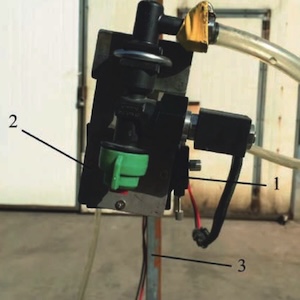A CFD simulation method for nozzle droplet deposition characteristics and corresponding experimental validation

HTML: 19
All claims expressed in this article are solely those of the authors and do not necessarily represent those of their affiliated organizations, or those of the publisher, the editors and the reviewers. Any product that may be evaluated in this article or claim that may be made by its manufacturer is not guaranteed or endorsed by the publisher.
Authors
Spray booms can often tilt during operation due to factors such as uneven ground, tires deformation and crop canopy structure and height, adversely affecting droplet deposition. Therefore, it is crucial to study and understand how spray height and nozzle tilt angle affect droplet deposition to enhance the effectiveness of Plant Protection Products (PPPs) application. The TeeJet®XR8002 nozzle was selected as the research object, and simulations and spray tests were conducted at three spray heights (0.5, 0.6, and 0.8 m) and 10 tilt angles (1°~10°). The film length and nozzle tilt angle were used to determine the relative position of the virtual origin and the center coordinates to determine the tilt angle of the spray model. Depositional characteristics at different spray heights were analyzed using the ratio of deposition and changes in the spray height. The dense spraying effect was observed when the nozzle was tilted at spray heights of 0.5, 0.6, and 0.8 m. For spray heights of 0.8, 0.6, and 0.5 m, the maximum allowable tilt angles were 4°, 3°, and 4°, respectively, to ensure that the effect of changes in tilt angle on droplets deposition is minimized. The maximum relative errors with respect to the experimental tests for the accurate deposition ratio and deposition ratio were 3.09% and 4.64%, respectively, thus validating the reliability of the simulation results.
Supporting Agencies
General Project of Liaoning Provincial Education DepartmentHow to Cite

This work is licensed under a Creative Commons Attribution-NonCommercial 4.0 International License.
PAGEPress has chosen to apply the Creative Commons Attribution NonCommercial 4.0 International License (CC BY-NC 4.0) to all manuscripts to be published.

 https://doi.org/10.4081/jae.2025.1708
https://doi.org/10.4081/jae.2025.1708



